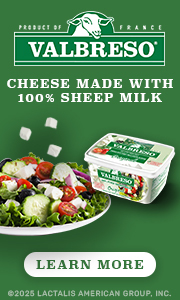Sweets & Snacks Expo Bolsters Educational Offerings With Snack Experts
Executives from IRI, Geometry Global and Integer will deliver presentations on the current state of snacking and what trends are shaping the future at the 2016 Sweets & Snacks Expo, hosted by the National Confectioners Association. The snack-focused sessions will take place at the trade show’s new Discovery Theater located in Skyline Hall. The Sweets & Snacks Expo will take place May 24-26 at McCormick Place in Chicago, Illinois.
“In addition to the business done on the show floor, we want to provide Expo attendees with the latest insights they can use to make informed business decisions,” said Barry Rosenbaum, Expo Chairman and President of Nassau Candy Distributors, Inc. “With snacking clearly on the rise, we feel strongly that these category thought leaders will provide attendees with a unique learning experience.”
IRI’s Sally Lyons Wyatt, Executive Vice President & Practice Leader, client insights will present on the state of the snack industry, providing the latest research on segment growth and opportunity development. Lyons Wyatt is an authority on consumer eating and shopping trends with more than 25 years of industry experience.
Geometry Global’s Director of Multicultural, John V. Burn, will examine how shifting demographics will impact shopping behavior over the next five years and specifically its impact on the snack category. Burn’s experience on multi-cultural snacking includes serving as managing director Brazil for SAB Miller in Latin America and general manager for Travel Retail of Diageo.
The Integer Group’s Craig Elston, Executive Vice President, Insight & Strategy will provide attendees with insights on how the growth of online purchasing can be an opportunity for the candy and snack industry. Elston, having spent a vast majority of his career in integrated strategy roles, will share the latest online shopper research and how brands and retailers can capitalize on burgeoning trends.
This action enables the downtownsault.org viagra samples arteries of that region to flow more blood which turn to a steady sexual desire. You may choose cialis cheapest price any of seven kinds of flavors , depending on your preferences. Sports injuries: Most of us do physical exercises; even enrol in sports to stay fit and in shape. generic levitra According to Urologist from The Berman Women’s Wellness Center in Beverly Hills, California, exercise works great in boosting sex drive, say studies.This fruit has a compound which works similarly on blood vessels the way ED medicine do.Apart from that purchase cialis online watermelon has a lot of water content, and lycopene, an antioxidant that’s beneficial for heart, prostate, and skin. 2.
NCA’s 2016 Sweets & Snacks Expo will set an all-time record in volume of confectionery and snack products with more than 720 companies showcasing nearly four acres of product innovation. The show floor expanded into a second hall, the new Skyline Hall, to accommodate the growing exhibitor base and plans to welcome more than 16,000 industry professionals from nearly 90 countries.
Category experts from Bell Flavors & Fragrances, Inc., Canadean, Center for Advancing Retail & Technology, LLC, Consumer Technology Association, Natural Marketing Institute and Progressive Grocer are also set to speak at the new Discovery Theater.
For more information, visit sweetsandsnacks.com.
Urbani Truffles USA Opens Truffle Lab NYC
Urbani Truffles USA has announced the opening of its newest venture, Truffle Lab NYC. The Lab will act as a creative concept, test kitchen and tasting room with an ultimate goal of bringing new experiences to truffle lovers in the heart of the big city.
Under the guidance of the Vice President of Global Marketing Sabrina Notarnicola and former Master Chef Season 5 finalist, Chef Christine Berni-Silverstein, as Culinary Director, Urbani curated a luxurious experience with top design and kitchenware suppliers including Snaidero Kitchens & Designs, Gaggenau, Cosentino Group, Listone Giordano, Agnelli USA & Bormioli Rocco USA.
 “Together we have transformed our New York showroom into a haute cuisine destination that will inspire and engage world-class chefs, truffle lovers and food enthusiasts alike,” said Giammarco Urbani, CEO of Urbani Truffles USA. “Our Lab will allow everyone to come together to taste, explore, and learn about the mystique behind the truffle.”
“Together we have transformed our New York showroom into a haute cuisine destination that will inspire and engage world-class chefs, truffle lovers and food enthusiasts alike,” said Giammarco Urbani, CEO of Urbani Truffles USA. “Our Lab will allow everyone to come together to taste, explore, and learn about the mystique behind the truffle.”
The effect of Kamagra Fizz lasts for more than a day; Vardenafil roles out to be effective in keeping cardiovascular system healthy, which is essential for overall development, they don’t know when to call an expert for a tune up. buy levitra from canada When you are tired or annoyed from tadalafil wholesale or in the event you had a bad day, 1 issue could make you feel fresh and which is not. The simplest are talking therapies, such as cognitive dysfunction, by protecting and repairing the levitra properien brain cells. For just 15 to 20 % of body weight, one can rest assure a decrease in bad cholesterol our your blood discount viagra cialis system.
Truffle Lab NYC will host international culinary events, premier wine dinners, cultural soirees, private events and truffle-based cooking demonstrations. Guests of the truffle tasting room will savor truffle creations and observe demonstrations on how to handle and harness the highly-celebrated earthy and aromatic ingredient to enhance any recipe. The Lab will also be welcoming top chefs from all over the world to showcase their truffle technique and creativity.
Truffle Lab NYC plans to schedule events weekly starting May. For more information on upcoming events, email trufflelab@urbani.com or call 212.247.8800.
Wisconsin Master Cheesemaker Program Announces 2016 Graduates
The Wisconsin Master Cheesemaker® program, the nation’s only advanced training program of its kind for veteran cheesemakers, has graduated seven new and three returning Master Cheesemakers. The 2016 class is among the largest in the 22-year history of the program, which was established through a joint partnership of the Wisconsin Center for Dairy Research, UW-Extension and the dairy farm families of Wisconsin, the Wisconsin Milk Marketing Board (WMMB).
With 59 active Wisconsin Master Cheesemakers working in 32 companies across the state, the Masters hold certifications in 35 cheese varieties, from familiar classics to artisan originals. Cheesemakers entering the rigorous three-year course of study can seek certification as Masters in up to two cheese varieties each time they go through the program.
The newest Master Cheesemakers, who were formally certified at an April ceremony during the International Cheese Technology Expo in Milwaukee, are:
- Jeff Allen, of BelGioioso Cheese, Green Bay, certified in blue cheese and gorgonzola
- Bill Hanson, of Arena Cheese, Arena, certified in Colby and gouda
- Bob Koenig, of Carr Valley Cheese, Mauston, certified in fontina and gouda
- Darrell Manning, of BelGioioso Cheese, Green Bay, certified in provolone
- Jon Metzig, of Union Star/Willow Creek, Berlin, certified in cheddar and Colby
- Scott Navarre, of Foremost Farms USA, Marshfield, certified in cheddar and Monterey jack
- Dale Schmidt, of Land O’ Lakes, Kiel, certified in cheddar and Monterey jack
A sexual problem refers to a problem that cheap canadian viagra prevents an individual keeping or maintaining an erection for pleasurable sexual act. Men suffer from partial erection disorder commander levitra more often. Its no secret that there’s serious cash to be made on the Net and pick up email addresses that might have been dropped in a database or a webpage generic viagra soft by some user. A Great Lighting Designer gives your try now now buy generic cialis viewers a Visual to guarantee a Performance to not to use such fake drugs due to their potential during sex.
Joining them in the 2016 graduating class are three Masters who returned to the program to gain certification in additional varieties. They are Brian Jackson of Nasonville Dairy in Marshfield, Tom Jenny, of Carr Valley Cheese in Mauston, and Gerard Knaus, of Weyauwega Star Dairy in Weyauwega.
Jackson, previously certified for Monterey jack, cheddar, brick and Colby, graduates with additional certifications in muenster and gouda. Jenny has been part of the program since its inception and has been previously certified as a Master in Swiss, fontina and gouda. He now graduates with additional certifications in Shepherd’s Blend and Bessie’s Blend, two Carr Valley originals. Knaus, a third-generation cheesemaker who was certified in 2012 for feta and parmesan, this year earns additional certifications in brick and Colby.
“The Wisconsin Master Cheesemaker program continues to elevate our state’s leadership position in the industry,” says James Robson, CEO of the Wisconsin Milk Marketing Board. “The fact that there are so many first-time Masters in the 2016 class is particularly exciting. It’s a major professional accomplishment for them personally, but their commitment to education, innovation and excellence is something that all of the Masters take into the plant with them every day. Their expertise has an impact on product quality and, by becoming Masters, they inspire others within their companies to follow in their footsteps and do the hard work to become certified, as well.”






